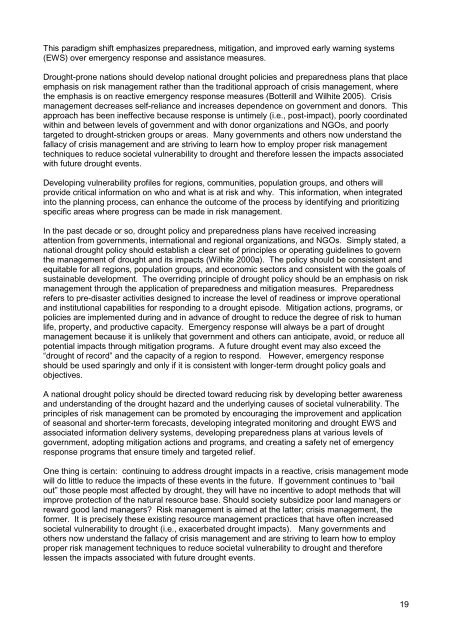Agricultural Drought Indices - US Department of Agriculture
Agricultural Drought Indices - US Department of Agriculture
Agricultural Drought Indices - US Department of Agriculture
Create successful ePaper yourself
Turn your PDF publications into a flip-book with our unique Google optimized e-Paper software.
This paradigm shift emphasizes preparedness, mitigation, and improved early warning systems<br />
(EWS) over emergency response and assistance measures.<br />
<strong>Drought</strong>-prone nations should develop national drought policies and preparedness plans that place<br />
emphasis on risk management rather than the traditional approach <strong>of</strong> crisis management, where<br />
the emphasis is on reactive emergency response measures (Botterill and Wilhite 2005). Crisis<br />
management decreases self-reliance and increases dependence on government and donors. This<br />
approach has been ineffective because response is untimely (i.e., post-impact), poorly coordinated<br />
within and between levels <strong>of</strong> government and with donor organizations and NGOs, and poorly<br />
targeted to drought-stricken groups or areas. Many governments and others now understand the<br />
fallacy <strong>of</strong> crisis management and are striving to learn how to employ proper risk management<br />
techniques to reduce societal vulnerability to drought and therefore lessen the impacts associated<br />
with future drought events.<br />
Developing vulnerability pr<strong>of</strong>iles for regions, communities, population groups, and others will<br />
provide critical information on who and what is at risk and why. This information, when integrated<br />
into the planning process, can enhance the outcome <strong>of</strong> the process by identifying and prioritizing<br />
specific areas where progress can be made in risk management.<br />
In the past decade or so, drought policy and preparedness plans have received increasing<br />
attention from governments, international and regional organizations, and NGOs. Simply stated, a<br />
national drought policy should establish a clear set <strong>of</strong> principles or operating guidelines to govern<br />
the management <strong>of</strong> drought and its impacts (Wilhite 2000a). The policy should be consistent and<br />
equitable for all regions, population groups, and economic sectors and consistent with the goals <strong>of</strong><br />
sustainable development. The overriding principle <strong>of</strong> drought policy should be an emphasis on risk<br />
management through the application <strong>of</strong> preparedness and mitigation measures. Preparedness<br />
refers to pre-disaster activities designed to increase the level <strong>of</strong> readiness or improve operational<br />
and institutional capabilities for responding to a drought episode. Mitigation actions, programs, or<br />
policies are implemented during and in advance <strong>of</strong> drought to reduce the degree <strong>of</strong> risk to human<br />
life, property, and productive capacity. Emergency response will always be a part <strong>of</strong> drought<br />
management because it is unlikely that government and others can anticipate, avoid, or reduce all<br />
potential impacts through mitigation programs. A future drought event may also exceed the<br />
“drought <strong>of</strong> record” and the capacity <strong>of</strong> a region to respond. However, emergency response<br />
should be used sparingly and only if it is consistent with longer-term drought policy goals and<br />
objectives.<br />
A national drought policy should be directed toward reducing risk by developing better awareness<br />
and understanding <strong>of</strong> the drought hazard and the underlying causes <strong>of</strong> societal vulnerability. The<br />
principles <strong>of</strong> risk management can be promoted by encouraging the improvement and application<br />
<strong>of</strong> seasonal and shorter-term forecasts, developing integrated monitoring and drought EWS and<br />
associated information delivery systems, developing preparedness plans at various levels <strong>of</strong><br />
government, adopting mitigation actions and programs, and creating a safety net <strong>of</strong> emergency<br />
response programs that ensure timely and targeted relief.<br />
One thing is certain: continuing to address drought impacts in a reactive, crisis management mode<br />
will do little to reduce the impacts <strong>of</strong> these events in the future. If government continues to “bail<br />
out” those people most affected by drought, they will have no incentive to adopt methods that will<br />
improve protection <strong>of</strong> the natural resource base. Should society subsidize poor land managers or<br />
reward good land managers? Risk management is aimed at the latter; crisis management, the<br />
former. It is precisely these existing resource management practices that have <strong>of</strong>ten increased<br />
societal vulnerability to drought (i.e., exacerbated drought impacts). Many governments and<br />
others now understand the fallacy <strong>of</strong> crisis management and are striving to learn how to employ<br />
proper risk management techniques to reduce societal vulnerability to drought and therefore<br />
lessen the impacts associated with future drought events.<br />
19

















